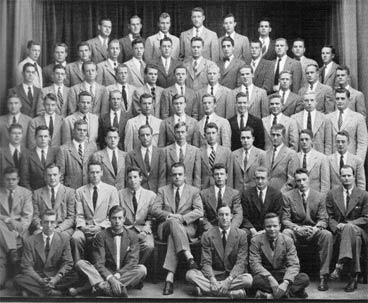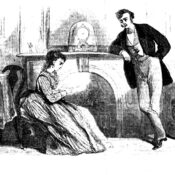Of all the people who wrote about conformity in the ‘60s, few are more unexpected than Walter Gropius. Gropius was (and still is) considered an intellectual heavyweight, not the sort of contributor usually found in the Post. Yet here he was — one of the pioneers of modern architecture — writing about the aesthetics and the human spirit in “The Curse of Conformity.”
Gropius was mainly concerned with conformity in architecture, but he recognized that buildings reflected society. And the conformity he saw in America’s buildings, and America’s cities, did not bode well for the people living in them.
Our biggest man-made objects—our cities—have steadily grown more chaotic and ugly, despite brilliant individual contributions to planning and design.
In our smaller towns people try hard to preserve a certain regional character and community spirit — a losing struggle against the conformity imposed by mass production… Man is in danger of losing his entity.
Our subservience to our own brain child, the machine, tends to stifle individual diversity and independence of thought and action—two factors which used to be strong components of the American image. We know, after all, that diversity in unity, not conformity, constitutes the fabric of democracy. Unless we can reconcile diversity with unity, we may end up as robots.
Another warning against conformity appeared in 1963 from an author no less surprising than Gropius: Hyman G. Rickover, a four-star admiral in US Navy. Rickover was one of those exceptional career officers who thrived in the regimented world of the military yet maintained a strong independent spirit. He had risen through the ranks to eventually be given the task of brining the Navy into the nuclear age. He had a reputation for being intelligent and dedicated, as well as outspoken, imperious, and intolerant of error.
In “The Decline of the Individual,” he saw conformity eroding the principals of freedom and equality in America. There was, he believed, a considerable threat —
“to individual freedom posed by huge power complexes which dominate our lives but over which we are not able to exercise control. Among these are both public and private organizations…
“In nearly all our large organizations, administration stands apart and above production. The men who do the real work of the organization are placed below the administrators who rule them. Administrators may or may not have competence in the organization’s special field of work; often they do. Unhappily they often do not.
“Nevertheless the individual who must work in a large organization, whether private or public, meets conditions of inequality not found elsewhere in our democratic society. Nor is this inequality necessarily a result of unequal human qualities; it comes because one party has behind him the power of the organization and uses it to prevail over the other. This reminds one uncomfortably of the special rights and privileges which once were enjoyed by men for no other reason than membership in a higher estate—as when society was divided into the nobility, the clergy and the third estate.
We have allowed the freedom of the individual to shrink while permitting the freedom of the organization to expand to a point where it over-shadows human liberties… Many people have been concerned over the danger of our becoming a state dominated by pressure groups.
These powerful organizations, enterprises, and lobbying groups affected many people but answered to very few.
What we must do, I submit, is find ways to curb the illegitimate powers of large organizations, both public and private. Government bureaucracies should be made more responsive to the wishes of the voters; this means bringing them under closer control of our elective bodies. Nongovernmental organizations—labor unions, professional associations, special-interest groups, even business corporations—ought to be held more strictly to the specific mandate of their charters, as well as to “public policy.”
Unless checked, these organizations would impose standards for citizens, which would shape their lives and their thoughts. It would stifle the creative thinking we needed to solve America’s problems.
All new ideas begin in a non-conforming mind that questions some tenet of the “conventional wisdom.” All improvements originate in a critical mind that mistrusts the “image” projected by some powerful organism. The innovator of ideas and the social critic are essential to a free society; they are what make the society free.
Conformity would also turn compliant and rebellious Americans against each other.
Increasingly, Americans seek comfort and security through belonging to a particular segment of society. People… pattern their personal behavior on group standards. What is particularly disturbing is the resentment that tends to be generated in these closed groups against anyone who thinks independently and who must therefore at times differ from approved “group thought.”
It is a sad comment on the decline of individualism in America that the critic has no friend at court. He is tagged “controversial,” the worst that can happen to anyone in a conformist society. The “controversial’ tag makes him by definition a “flawed” personality, not group-adjusted, one-sided, ill-informed, frustrated and motivated by ill will. Epithets may therefore be thrown at him with impunity; he may be misquoted and misrepresented, and what he says may be contemptuously dismissed as requiring no refutation whatever.
Rickover’s concern seems to have been substantiated in a Post editorial two years later, “Our Threatened Way of Life.”
If a recent poll by Lou Harris is to be believed, a phenomenal number of citizens seem to think that virtually any kind of unusual behavior is a dire peril to the American Way of Life. The question was: “We would like to know whether you think each of these different types of people is more helpful or more harmful to American life, or don’t they help or harm things much one way or the other?”
The number of activities that seem to be considered “harmful” is quite appalling. “People who don’t believe in God,” for example, are condemned as “harmful” by 72 percent, a figure even higher than the one for prostitutes (70 percent). Fully 50 percent condemn “working career women with young children” as harmful, and no less than 36 percent apply the same condemnation to “women who wear bikini bathing suits.” [was 1965 really that far back in history?] As for the younger generation, they catch it both ways — 45 percent rating it harmful to be “more interested in athletics than studies,” while 10 percent consider it harmful for students to “read books all the time.”
It is possible that the American Way of Life consists entirely of neat little people leading neat little lives in neat little houses, but we somehow doubt it. Thomas Jefferson was something less than a steady churchgoer, Henry David Thoreau served time in prison, Mark Twain was a bankrupt, and General Ulysses S. Grant was an alcoholic — to name just a few of the unorthodox men who have helped make our way of life what it is. And it is, among other things, a strong and resilient way of life, capable of absorbing and surviving our oddities, aberrations and misdemeanors.
Become a Saturday Evening Post member and enjoy unlimited access. Subscribe now



